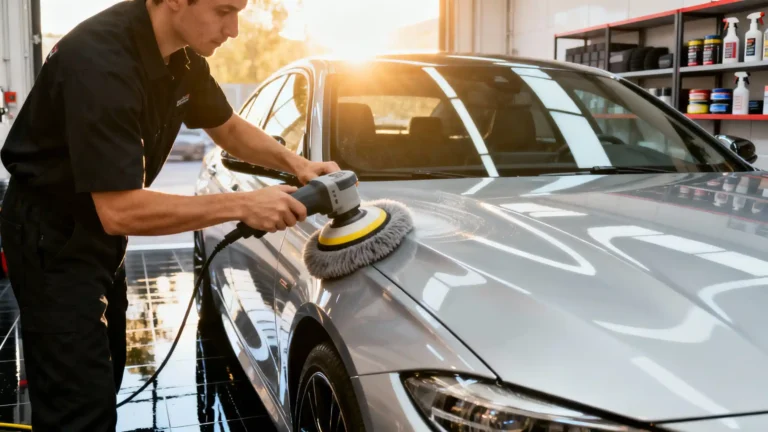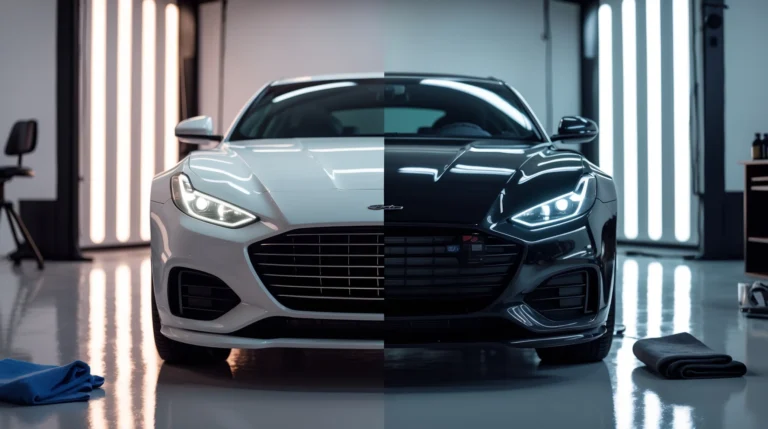Have you ever looked at a sleek car with tinted windows and thought, “I want that too”? You’re not alone. Many car owners want the same clean look and comfort that tinted windows provide. The good news? You can learn to do it yourself auto tint without hiring a professional. It’s a fun and useful project you can do at home. In this guide, we’ll walk you through everything step by step. Whether you’re working on your car in the garage or driveway, tinting your windows yourself is possible with the right tools, knowledge, and a bit of patience.

Why Window Tinting Is Popular for Cars Today
People tint their windows for many reasons. One of the biggest is protection. Tinted windows help block the sun’s harmful rays. This keeps the inside of your car cooler and protects the seats from fading. It also adds privacy. People can’t see in as easily, but you can still see out. Tint also makes your car look stylish. It gives it a cleaner, sharper appearance. That’s why more drivers want to try car tinting at home to get the benefits without spending a lot of money.
What Does ‘Do It Yourself Auto Tint’ Really Mean?
When we talk about do-it-yourself auto tint, we’re talking about applying a special film to your car windows by yourself. This film sticks to the inside of the glass. It helps block sunlight and makes your car look great. It also means taking charge of the project. You don’t need to be a pro, but you do need to follow the right steps. With basic tools and some careful work, you can get results that look just as good as what a shop might do.
Many people try this at home because it saves money, gives them control, and helps them learn something new.
Can I Tint My Windows Without Experience?
Yes, you can, but it takes time and care. If you’re asking, “Can I tint my windows?” the answer is yes, but you’ll need to be patient and pay attention to detail. Start with easier windows like the rear side windows before doing curved glass like the back window. If you rush or don’t clean the windows properly, dust and air bubbles can get trapped under the film.
Still, many beginners get great results with their first try. Using a do-it-yourself tint kit makes the process easier. These kits often include pre-cut film, a spray bottle, a squeegee, and a razor blade.

Understanding DIY Tint Options: Film, Spray, or Ceramic?
When it comes to DIY tint, you have a few choices:
- Tint Film – This is the most common method. You apply thin film sheets to the inside of your windows. It gives a clean look and is widely available.
- Tinting Spray for Windows – This spray-on tint is easy to apply but harder to make look perfect. It’s not as popular because it can be uneven.
- DIY Ceramic Window Tint – Ceramic tint blocks more heat and UV rays than regular film. It costs more but lasts longer and works better.
Each option has pros and cons. Most people use film because it’s affordable, effective, and produces a good result when applied correctly.
Tools You Need for Car Window Tinting at Home
To start car tinting at home, you’ll need some simple tools:
- Window tint film (buy extra in case of mistakes)
- Spray bottle with soapy water
- Squeegee or soft plastic card
- Razor blade or cutting knife
- Heat gun (optional but helpful)
- Microfiber cloth
- Lint-free paper towel
These tools help you clean, cut, and apply the tint smoothly. Always make sure your workspace is clean and free from wind or dust. This helps keep dirt out from under the film.
A diy tint kit often includes many of these items already.

Step-by-Step: How to Tint Windows Yourself Safely
Here’s how to tint your windows yourself, one step at a time:
- Clean the window – Use soapy water and a razor blade to remove dirt or stickers.
- Cut the tint film – Lay it over the outside of the window and trim it to fit, leaving a small edge.
- Spray the inside – Use your tint solution to wet the inside of the glass.
- Apply the film – Peel off the backing and place the sticky side against the glass.
- Smooth it out – Use your squeegee to press out air bubbles and water from the center outward.
- Trim the edges – Carefully cut off extra film with a razor blade.
- Let it dry – Don’t roll down the windows for a few days.
That’s it! If you’re asking how to DIY tint car windows, the trick is to work slowly and be patient.
Making Your Window Tint Solution Without Baby Shampoo
Most tint guides tell you to use baby shampoo in your tint solution. But what if you don’t have any?
Here’s how to make a window tint solution without baby shampoo:
- Mix 1 teaspoon of dish soap (like Dawn) with 1 quart of clean water.
- Put it into a spray bottle and shake gently.
This solution works well to help you slide the film into place before it sticks. Just don’t use harsh soap that could leave streaks or damage the film.
This small step makes the entire job easier and cleaner.
Tips for Removing Old Window Tint Before Starting
Before you start your DIY car tint, you may need to remove the old tint first. Old film can bubble, peel, or turn purple over time.
To do window tinting removal, here’s what you need:
- Heat gun or hairdryer
- Razor blade
- Glass cleaner
Steps:
- Use heat to soften the adhesive behind the film.
- Peel up one corner and slowly pull the film off.
- Use a razor blade and glass cleaner to remove any leftover glue.
Clean the window well before applying new film. This step is important for a clean finish and helps your new tint stick properly.
How Much Tint Do I Need for My Car? A Quick Guide
This is a great question: How much tint do I need for my car?
It depends on your car type, but here’s a simple guide:
- Sedan – About 25–30 feet of tint film
- SUV or Truck – 35–40 feet
- Two-door car – 20–25 feet
If you’re unsure, it’s better to buy extra. Mistakes happen, and having more film on hand is better than running out halfway through.
You can also use online tools to help estimate how much you’ll need based on your vehicle model.

Do It Yourself Auto Tint in Farmington Hills: Local Tips
If you live in Farmington Hills, keep local weather in mind. Cold weather makes tint harder to apply because it dries more slowly. Spring and summer are better for this kind of project. Also, check your state’s laws. Michigan, for example, limits how dark your front window tints can be. You want your DIY tint to look great and be legal, too. When in doubt, talk to experts at Riveautohaus. They know the local rules and can help you with film, tools, or even installation if you change your mind about doing it yourself.
Final Thoughts from riveautohaus: Is DIY Tinting Right for You?
Learning how to do it yourself, auto tint is a great way to save money and learn a new skill. It gives you more control over the look and feel of your car. Plus, you’ll feel proud every time you see the finished result. That said, it’s not for everyone. If you don’t have the time or patience, a professional can do the job quickly and perfectly. Whether you go DIY or want help, the team at RiveAutohaus is here to guide you. We love helping car lovers take care of their rides the right way.
Ready to give your car a fresh look? Try tinting your windows at home or contact our team for expert advice and help with everything you need to get started.


